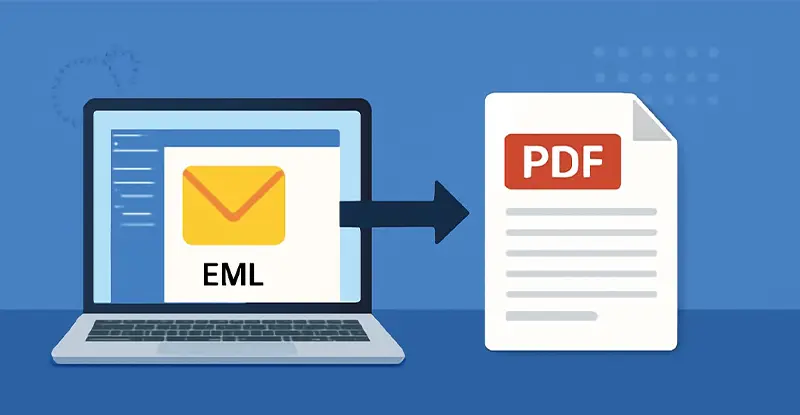How to Convert EML to PDF:
Complete Guide for Email Management


Email management presents significant challenges for professionals and organizations dealing with large volumes of correspondence. EML files, while common for individual email storage, often create limitations when sharing, archiving, or presenting email content. Using an eml to pdf converter has become an essential solution for transforming emails into a universally accessible format. This guide explores the benefits of converting EML to PDF and provides practical advice for implementing effective email management strategies.

Turn unstructured email attachments into fully searchable, structured PDFs with the help of docAlpha. By using intelligent OCR and data extraction, docAlpha enhances your document conversion process and feeds clean, actionable data directly into your business systems.
EML (Electronic Mail Format) files serve as containers for individual email messages, storing the message content, sender information, recipient details, and attachments in a MIME-encoded format. While useful for certain applications, EML files present several significant limitations in professional environments.
The primary challenge with EML files is compatibility across different systems and email clients. An EML file created in Microsoft Outlook may not display correctly in Mozilla Thunderbird or other email applications. This inconsistency creates barriers when sharing email correspondence with colleagues, clients, or legal entities who use different software ecosystems.
Additionally, EML files often require the recipient to have an email client installed to view the content properly. This dependency creates unnecessary complications when attempting to share critical information with external stakeholders who may not have compatible software. For organizations that need to preserve email communications for compliance, legal, or historical purposes, these limitations can create significant workflow inefficiencies.
Recommended reading: How to Use OCR Software for PDFs and Other File Formats
Converting EML files to PDF format solves many of the challenges associated with email storage and sharing. According to Adobe's PDF resource center, PDF was designed specifically to present documents consistently across different platforms and devices. This universal compatibility makes PDF an ideal format for email archiving and distribution.
Key advantages of PDF conversion include:
Eliminate Manual Invoice Entry From Emails
If your AP team receives invoices as email attachments, InvoiceAction can automatically extract invoice data, validate it, and post it directly into your ERP system. It transforms EML files into structured, actionable data, streamlining the entire accounts payable process from inbox to ERP with speed and accuracy.
Book a demo now
PDF format provides enhanced security features that protect sensitive email content. When converting emails to PDF, organizations can implement password protection, encryption, and permission controls to manage document access. This security layer becomes particularly important when handling confidential correspondence or regulated communications.
The format also preserves the visual integrity of email messages, ensuring that formatting, images, and layout remain consistent regardless of where the document is viewed. This preservation of visual elements makes PDF ideal for legal documentation, where the exact appearance of communications may have significant implications.
Recommended reading: Unlock Efficiency With Step by Step PDF OCR Conversion
When selecting an EML to PDF conversion solution, several critical features determine efficiency and effectiveness. The ideal conversion tool should balance user-friendly operation with powerful technical capabilities.
Key features to evaluate in conversion software:
Batch processing capabilities deserve special attention for organizations dealing with large email archives. Converting hundreds or thousands of emails individually would create an impossible workflow bottleneck. Effective conversion tools automate this process, maintaining folder structures and applying consistent settings across multiple files.
Automate Order Capture Directly From Emails
Stop manually entering customer orders sent via email. With OrderAction, you can extract data from EML attachments and transform them into validated, structured orders ready for fulfillment. Boost accuracy and reduce cycle time effortlessly.
Book a demo now
Before beginning the conversion process, proper preparation ensures optimal results. According to email archiving best practices from TechTarget, organizations should establish clear protocols for email retention and categorization before implementing technical solutions.
Preparation steps for effective conversion:
The actual conversion process typically follows these essential steps, though specific implementations may vary depending on the software used:
During conversion, pay particular attention to handling of attachments. Most quality converters offer options to either embed attachments within the PDF or extract them as separate files. The appropriate choice depends on your specific use case and document management requirements.
Recommended reading: Document Processing Guide: Transforming Your Business with Intelligent Automation
Converting emails to PDF represents only one component of a comprehensive email management strategy. To maximize the value of converted documents, implement these best practices:
Organizations that implement these practices create more than just an email archive, they develop a searchable knowledge base of institutional communications that supports compliance, decision-making, and operational continuity.
Simplify Complex Email Attachments With Intelligent OCR
Whether you're managing purchase orders, invoices, or forms sent via email, docAlpha’s intelligent process automation platform can extract, classify, and route data to the right systems, turning email clutter into structured, searchable content.
Book a demo now
Converting EML files to PDF format addresses critical challenges in email management, providing a universal format for sharing, archiving, and presenting email correspondence. The right conversion approach creates documents that remain accessible, secure, and visually consistent across different platforms and time periods.
Key Takeaways:
By implementing the strategies outlined in this guide, organizations can transform their email archives from potential liabilities into valuable information assets that support operational excellence and compliance requirements.